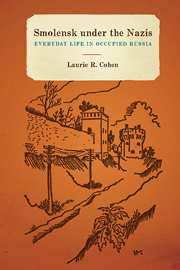Book contents
- Frontmatter
- Contents
- Acknowledgments
- Abbreviations
- Introduction
- Part 1 Methodologies
- Part 2 A Record of the War and Occupation
- Part 3 Popular Attitudes, Propaganda, and Enemy Imagery
- 6 Between Stalinists and Nazis: The Long-Term Aims and Long-Lasting Effects of Occupation
- 7 Propaganda and Persuasion
- 8 Group Perceptions, Oral Narratives
- 9 Sex/Gender Relations and Youth Experiences
- Part 4 Restoration and Reconstruction
- Conclusion
- Notes
- Bibliography
- Index
6 - Between Stalinists and Nazis: The Long-Term Aims and Long-Lasting Effects of Occupation
from Part 3 - Popular Attitudes, Propaganda, and Enemy Imagery
Published online by Cambridge University Press: 05 December 2013
- Frontmatter
- Contents
- Acknowledgments
- Abbreviations
- Introduction
- Part 1 Methodologies
- Part 2 A Record of the War and Occupation
- Part 3 Popular Attitudes, Propaganda, and Enemy Imagery
- 6 Between Stalinists and Nazis: The Long-Term Aims and Long-Lasting Effects of Occupation
- 7 Propaganda and Persuasion
- 8 Group Perceptions, Oral Narratives
- 9 Sex/Gender Relations and Youth Experiences
- Part 4 Restoration and Reconstruction
- Conclusion
- Notes
- Bibliography
- Index
Summary
In the course of life all kinds of defense mechanisms continued to function. They comfortably enveloped us, so that we would not scream of horror. We do not see the full picture of the lived life, only a part of it. And this part adapts to us or we adapt ourselves to it. And now at times, I experience retrospective horror. The “abyss of humiliation” opens in front of me. How did we walk into this abyss, step by step, not missing anything …?
—Lydiia GinzburgStalinism
Prior to 1941, the Stalinist regime, promoting a policy of “socialism in one country,” encouraged its citizens to believe that it was constructing a utopian socialist welfare state. One means to this end was state control of the entire political apparatus and suppression of domestic opposition, even potential opposition. Stalin, for instance, on November 7, 1937, declared: “We will mercilessly destroy anyone who, by his deeds or his thoughts—yes, his thoughts!—threatens the unity of the socialist state. To the complete destruction of all enemies, themselves and their kin!” Repression of dissent and enforced obedience reached a peak during an extended period of mass terror in the late 1930s. The majority of those accused of being “enemies of the people” were so-called kulaks returning home from exile, suspect “White Army” officers, ordinary Russians with relatives living abroad, and religious believers.
- Type
- Chapter
- Information
- Smolensk under the NazisEveryday Life in Occupied Russia, pp. 135 - 147Publisher: Boydell & BrewerPrint publication year: 2013

